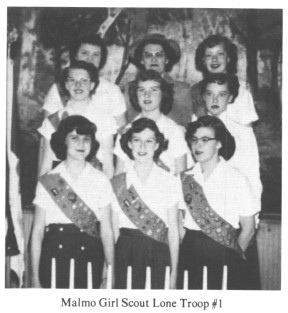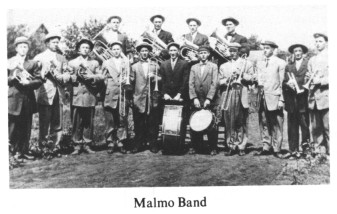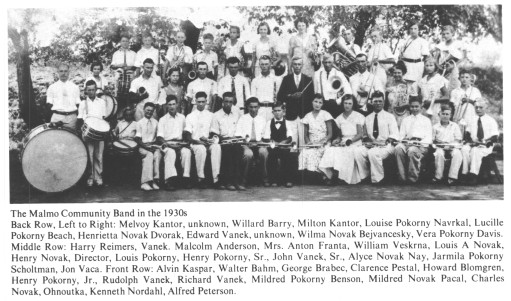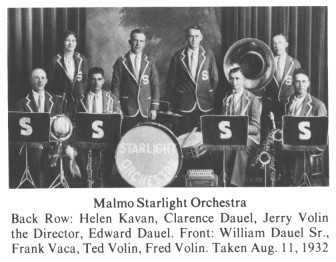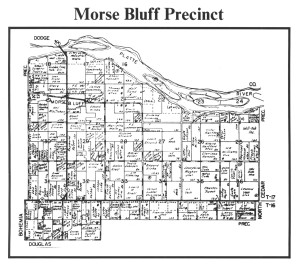 |
MARIPOSA PRECINCT |
MALMO COMMUNITY BAND |
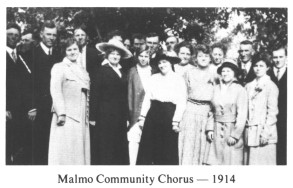 |
| Malmo Community Chorus -- 1914 |
MORSE BLUFF PRECINCTMorse Bluff Precinct was created out of the northern part of Douglas Precinct, which was one of the first three organized December 3, 1866. The village of Morse Bluff, the only town in the precinct today, lays 1½ miles south of the Platte River on Hiway 79. It was platted in 1887 on land originally owned by William Wheeler and later transferred to Chester LeRoy Morse of North Bend, just across the river. It was on the David City branch of the Chicago and Northwestern Railroad which was built through the town in the same year. The town was named for Mr. Morse and the Bluff was added so as not to confuse it with another Morse on the same railroad line. The Bank of Morse Bluff was organized in 1890. Officers were Jesse Gidley, president and J.C. Hall, cashier. In 1910 a water system was installed. Today the township officers for the 1983-87 term are Keith F. Racek, Chairman; Eugene L. Hartford, Clerk; and William Kracl, Treasurer. ANTON CUHEL FAMILY HAS |
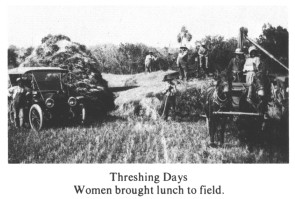 |
| Threshing Days Women brought lunch to field. |
They decided they had finally saved enough for the trip. Boat transportation was secured and paid for and all arrangements completed.
Mrs. Cuhel packed and made brown bread for the family to eat as they only had enough money for the boat fare and farm. When morning came on the day of leaving, Mrs. Cuhel was found dead. Everyone was shocked, of course, but they had to make the best ofthe situation. They had to leave and there was no money for a funeral, so Mr. Cuhel made a small grave and buried her himself.
Everyone was made ready to leave. Each child had a cloth sack packed with the family possessions and two loaves of hard rye bread. There were eight children and the youngest being only two, missed his mother a great deal.
They had quarters on the ship far down below as it was cheaper. Mr. Cuhel found odd jobs for which he received hot coffee for the family to go with the bread they brought.
After arriving in America, they still had to get to Nebraska. He met a policeman in Philadelphia who helped him get money for train fare. He was Czech also, so it was easy for them to talk. He also gave them money for food as the bread was gone and the children were hungry.
The man he had written met them at the station in North Bend and took them to the farm. It was near North Bend and Morse Bluff with no buildings, only hills, so Mr. Cuhel figured he could make a dugout. He paid the man, who promised to send papers by mail and handed him a piece of paper with something written on it, which he said was a receipt.
That night the family slept under the stars. Their dream of a home had finally come true. The next morning as they were digging the dugout, a man came and told them this was his land. It was evident the real estate man had been a crook.
Things were really bad now. No farm, no money, and nowhere to go. It happened that there was a farmer nearby who was very sick and could use their help. They went to his farm where Mr. Cuhel and the boys built another dugout to live in while they worked for him.
The older children worked in the dugout, washing, cooking and cleaning. It was hard work, but at least now they were in America. About four years later Mr. Cuhel brought home a new wife which helped ease the burden on the small ones.
DATEL FAMILY, EARLY
SETTLERS
One of the earliest settlers in the Morse Bluff vicinity was Joseph Datel and family. Mr. Datel was born in 1826 in Kolec, Czechoslovakia. His wife, Anna Sukova was born in Kobelinki, Austria. They were married in Austria on May 25, 1852, and came to America in 1867 bringing their seven children with them. One of the children died on the voyage and was buried at sea.
The family first lived at Fort Madison, Iowa where Mr. Datel worked at his trade as a blacksmith. In 1871 they moved to Saunders County and located on a farm south of Morse Bluff. Here he farmed and did blacksmithing. He spoke and was able to read Bohemian, German and English. Mrs. Datel, however, never learned English.
In 1882 they moved to North Bend where he bought a blacksmith shop. In all 12 children were born. Mr. Datel died in 1902 and his wife lived to be 94.
MORSE BLUFF SCHOOL
DISTRICT 14
The first school building in Morse Bluff District #14 was located south of the present building. Some students would drive a horse and buggy many miles to school and stable their horse in a small family
page 94
| Back | Contents | Next |
The Saunders County NEGenWeb Project
